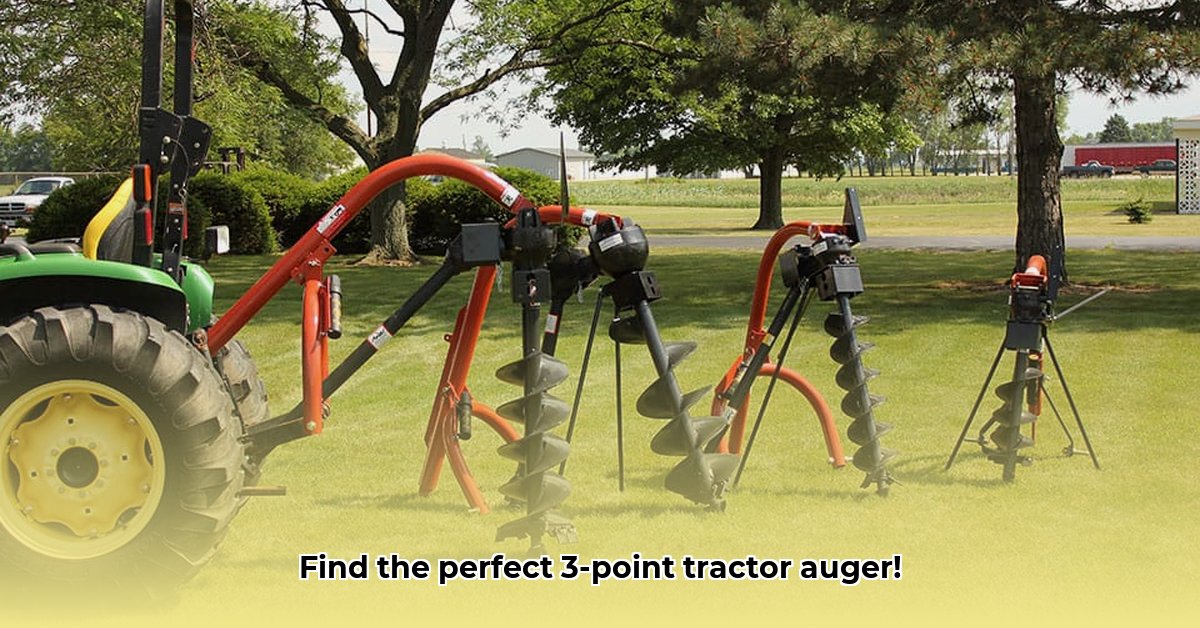
Choosing the right 3-point tractor auger can significantly boost efficiency for various tasks, from planting trees to setting fence posts. This comprehensive guide helps you navigate the selection process, ensuring you get the most out of your investment. We'll cover auger types, sizing, compatibility, operation, maintenance, and troubleshooting, equipping you with the knowledge to make an informed decision. For more on tractor hitches, see this helpful resource on tractor linkage.
3pt Tractor Augers: A Comprehensive Guide
A 3-point tractor auger is a powerful attachment driven by your tractor's power take-off (PTO), significantly increasing your digging capabilities. Its versatility extends to diverse applications including landscaping, agriculture, and even small-scale construction. However, selecting the correct auger requires careful consideration of various factors. Understanding these factors is key to maximizing its effectiveness and lifespan.
Choosing the Right Size and Type: Matching Auger to Task
Auger diameter is a crucial factor, influencing both its capabilities and the type of tractor it requires.
Smaller Augers (6-9 inches): Ideal for planting smaller shrubs, saplings, or setting smaller posts. Their maneuverability in tighter spaces is a significant advantage. Are these augers right for your smaller projects?
Medium Augers (12 inches): Offering greater versatility, these handle a wider range of tasks, from planting larger trees to setting posts in more challenging soil. They represent a good balance between capability and maneuverability. What are the most common applications for 12-inch augers?
Larger Augers (18 inches and up): Designed for heavy-duty applications like setting large fence posts, preparing foundations or tackling particularly dense or rocky soil. These demand powerful tractors and are usually reserved for larger-scale projects. How much horsepower does your tractor need for larger augers?
Beyond diameter, consider the auger's construction material. Tougher materials are essential for rocky or hard-packed ground, although they generally come with a higher price tag.
Matching Auger to Tractor: Power and Compatibility
Before purchasing, verify your tractor's PTO horsepower rating. This is critical for safe and effective operation. Underpowering an auger leads to inefficient digging and potentially damages the tractor's transmission. Always consult your tractor's manual and compare its specifications to the auger's requirements. Remember: A small tractor cannot effectively handle a large auger, just as a small car cannot tow a heavy trailer. What is the recommended margin of safety for PTO horsepower?
Assembling and Using Your Auger: A Step-by-Step Process
Always refer to the manufacturer’s instructions, but here's a general guideline:
Attach the Auger: Securely connect the auger to your tractor's 3-point hitch, ensuring all pins and locking mechanisms are properly engaged.
Engage the PTO: Carefully engage your tractor's PTO to power the auger.
Start Slowly: Begin drilling slowly, gradually increasing speed as needed to gauge the auger's interaction with the soil.
Depth Control: Adjust the auger's depth setting for consistent hole depths.
Safety Precautions: Wear appropriate safety gear (eye protection, gloves) and maintain awareness of your surroundings. Never operate near others.
Troubleshooting: If the auger struggles, first check PTO engagement and connections. Shear bolts are a common failure point; keep replacements handy.
Maintenance and Spare Parts: Ensuring Longevity
Regular maintenance significantly extends an auger's lifespan. Inspect after each use, checking for wear and tear. Lubricate moving parts as needed. Cleanliness is crucial in preventing premature wear. The availability of spare parts varies, so check with the manufacturer or retailer beforehand. Having essential spares on hand minimizes downtime. What are the most common parts that need replacing in 3-point tractor augers?
Brand Comparisons and Considerations
Numerous manufacturers produce 3-point tractor augers, each with unique features. Thorough research, including reading user reviews, is crucial before committing to a purchase. Consider factors like build quality, ease of assembly, spare part availability, and warranty provisions. Are there any independent testing organizations that evaluate 3-point tractor augers?
Advantages and Disadvantages: A Balanced Perspective
While 3-point tractor augers offer numerous benefits, potential drawbacks must also be considered.
| Pros | Cons |
|---|---|
| Increased efficiency and speed | Potential compatibility issues with tractors |
| Versatile applications | Requires significant tractor horsepower |
| Durable construction (in most models) | Relatively high initial cost |
| Significant time savings | Regular maintenance and lubrication needed |
Conclusion: Making the Right Choice
Investing in a 3-point tractor auger requires careful planning and research. Choosing the right size, ensuring compatibility with your tractor, and understanding maintenance requirements are vital for maximizing its performance and longevity. By following the guidelines in this guide, you'll be well-equipped to select an auger that fits your needs and enhances your productivity for years to come. What are the three most important factors to consider when buying a 3-point tractor auger?